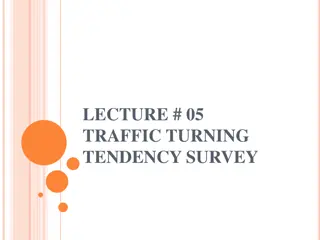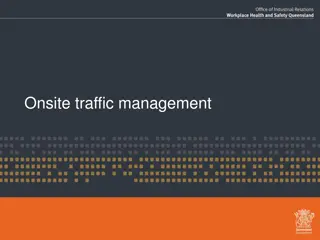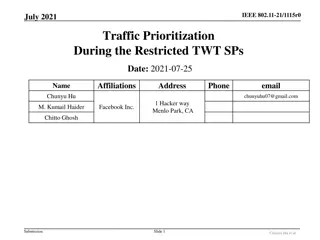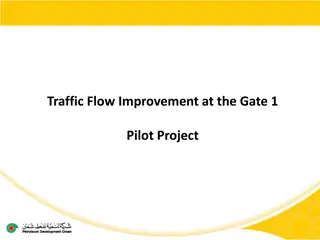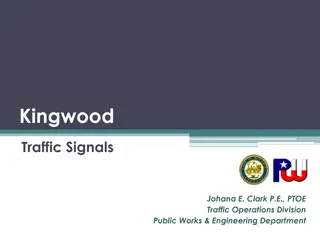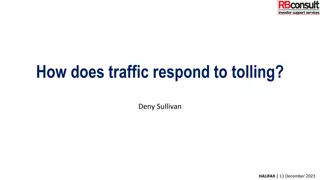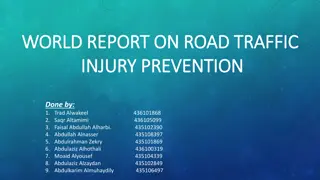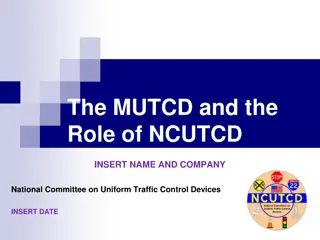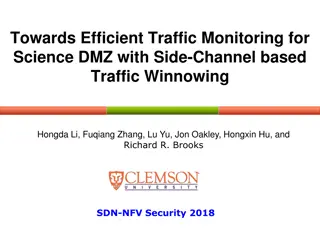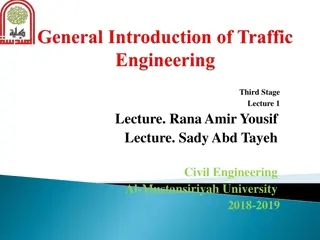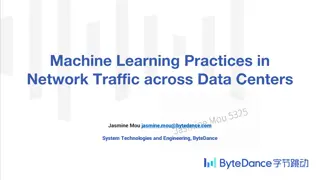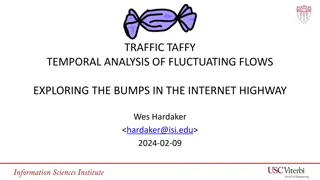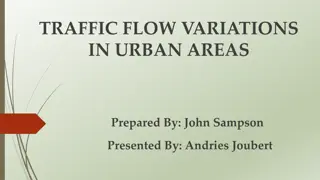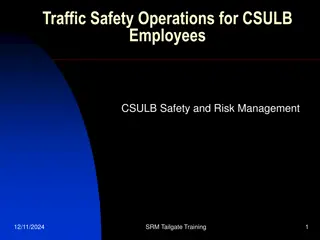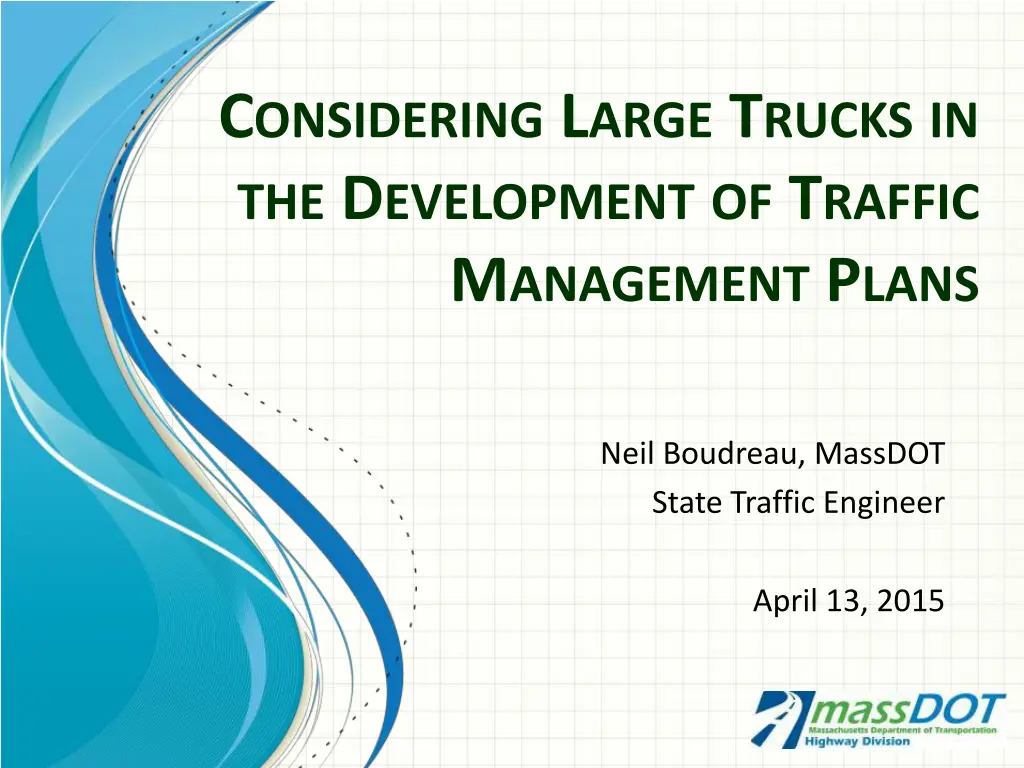
Traffic Management Strategies for Large Trucks in Work Zones
Explore the importance of Traffic Management Plans (TMP) in handling work zone impacts of road projects involving large trucks. Learn about Temporary Traffic Control Plans (TTCP) and key components like Advance Warning Areas, Transition Areas, and Activity Areas, essential for safe and efficient traffic flow in work zones.
Download Presentation

Please find below an Image/Link to download the presentation.
The content on the website is provided AS IS for your information and personal use only. It may not be sold, licensed, or shared on other websites without obtaining consent from the author. If you encounter any issues during the download, it is possible that the publisher has removed the file from their server.
You are allowed to download the files provided on this website for personal or commercial use, subject to the condition that they are used lawfully. All files are the property of their respective owners.
The content on the website is provided AS IS for your information and personal use only. It may not be sold, licensed, or shared on other websites without obtaining consent from the author.
E N D
Presentation Transcript
CONSIDERING LARGE TRUCKS IN THE DEVELOPMENT OF TRAFFIC MANAGEMENT PLANS Neil Boudreau, MassDOT State Traffic Engineer April 13, 2015
What is a Traffic Management Plan (TMP)? The TMP lays out a set of coordinated transportation management strategies and describes how they will be used to manage the work zone impacts of a road project These strategies include: temporary traffic control measures and devices public information and outreach operational strategies The scope, content, and level of detail of a TMP may vary based on the State or local transportation agency's work zone policy and the anticipated work zone impacts of the project National Symposium on Work Zones and Large Trucks April 13, 2015 2
Temporary Traffic Control Plan (TTCP) Four main components to a TTCP setup and each one has considerations when designing for Large Trucks Advance Warning Area Transition (taper) Area Activity Area (includes Buffer Space and Work Space) Termination Area National Symposium on Work Zones and Large Trucks April 13, 2015 3
Advance Warning Area The section of highway where road users are informed about the upcoming work zone with signs: Advance road work signs provide direction to action required Higher speed roadways require more signs of a larger size To ensure mobility for large trucks, need to provide adequate advance notice of unexpected changes in the roadway alignment National Symposium on Work Zones and Large Trucks April 13, 2015 4
Transition (Taper) Area The section of highway where road users are redirected out of their normal path of travel Tapers are strategically designed to meet the operating speed and road characteristics Consider distance large trucks need to make lane shifts and impacts of grade changes April 13, 2015 National Symposium on Work Zones and Large Trucks 5
Activity Area The section of the highway where the work activity takes place and often includes a buffer zone to allow for recovery of an errant vehicle Things to consider regarding large trucks: Lane Widths Need to ensure adequate width for large trucks and off-set to other lanes/obstructions Positive Protection Use of temporary barrier (concrete or steel) should be test-level rated for large trucks Work Area Access Need to provide access/egress for trucks entering the work zone National Symposium on Work Zones and Large Trucks April 13, 2015 6
Termination Area The section of the highway where road users are returned to their normal driving path This area extends from the downstream end of the work area to the last TTC device such as the End Road Work sign Use caution when transitioning heavy truck traffic back to normal lanes April 13, 2015 National Symposium on Work Zones and Large Trucks 7
Essential Traffic Control Devices Arrow Boards Temporary Traffic Barriers Temporary Markings / Lane Separators Warning Lights Temporary Traffic Control Signals April 13, 2015 National Symposium on Work Zones and Large Trucks 8
Work Zone Safety TCDs WZS Grant Products Virginia DOT Truck Mounted Attenuators Signing for egress points Temporary Rumble Strips Notification of Narrow Lanes Virginia DOT April 13, 2015 National Symposium on Work Zones and Large Trucks 9
Keys to TMP Planning and Design Understand the vehicle classification and traffic volumes on the roadway. 1 Determine minimum width and number of lanes required. Are shoulder lanes necessary for TTCP? 2 Explore construction staging plans for options: cross-over travel lanes, detours or alternate routes. 3 April 13, 2015 National Symposium on Work Zones and Large Trucks 10
Example TTC Plan The following Typical Application shows an example of a lane closure A.Long-Term and Intermediate B.Short-Term How do truck % fit into these plans? April 13, 2015 National Symposium on Work Zones and Large Trucks 11
Designing TTCP for Large Trucks Design Elements Ensure lane width supports truck traffic Provide sufficient taper length for lane drops Maintain adequate accel/decel lane lengths Avoid speed differentials Check turn radii for all interchange/intersection locations April 13, 2015 National Symposium on Work Zones and Large Trucks 12
Accommodating Large Trucks Understand the constraints controlling the construction means and methods Restrict trucks to designated lanes Is detouring traffic a possibility, or is an alternate route available? Is it feasible to create a Trucks Only route? MassDOT Virginia DOT April 13, 2015 National Symposium on Work Zones and Large Trucks 13
Queue Warning System Used to alert motorists of stopped traffic before they reach the back of queue Helps to prevent rear-end crashes before they happen National Symposium on Work Zones and Large Trucks April 13, 2015 14
Dynamic Merge System Early merge: In low-volume conditions reduces the occurrence of high-speed merging at the point of lane closure Late merge: In high-volume conditions reduces the length of the queue FHWA Operations Work Zone Safety Street Smart Rental April 13, 2015 National Symposium on Work Zones and Large Trucks 15
Best Practices for Large Trucks Outreach Early engagement of Statewide Trucking Association on expected traffic impacts and to encourage diversion if possible Communication Use of HAR system or CB Wizards for real-time notification Incident Response Consider on-call tow services for narrow cross-section or crossover conditions MassDOT April 13, 2015 National Symposium on Work Zones and Large Trucks 16
Summary Understand the TTCP Requirements Traffic control devices = safety for all road users Design for Location Specific Conditions Need to understand the field conditions/impacts Stakeholder Outreach Communicate plan and respond to feedback Assess work zone operations No plan is perfect. Implement, monitor, evaluate and adjust to improve safety & mobility April 13, 2015 National Symposium on Work Zones and Large Trucks 17
QUESTIONS Neil Boudreau, MassDOT State Traffic Engineer Email: neil.boudreau@state.ma.us Phone: (857) 368-9655 April 13, 2015 National Symposium on Work Zones and Large Trucks 18

